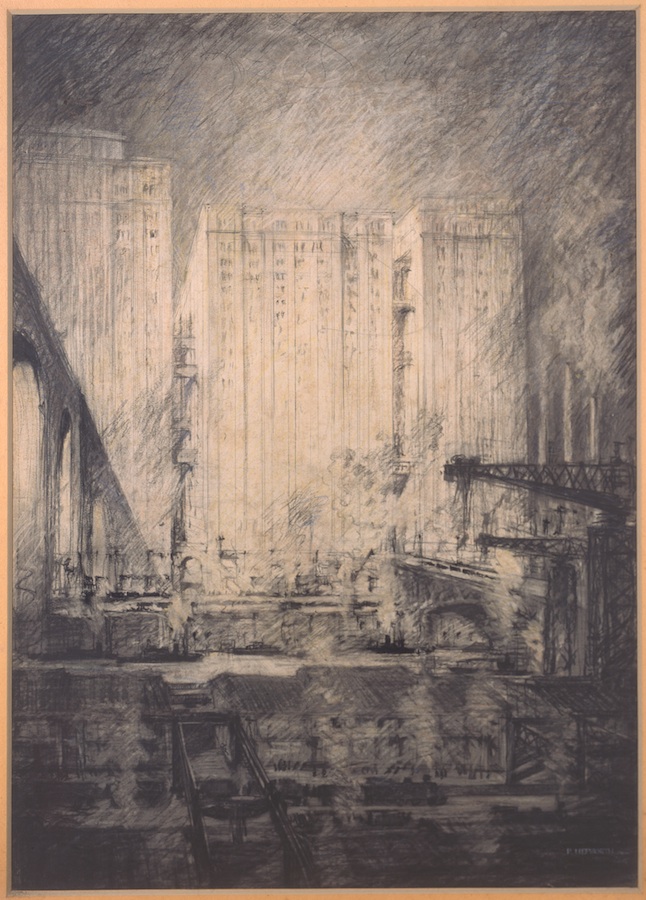Philip Dalton Hepworth (1890-1963)
L'Usine, 1922
Click on the image for a larger picture

|
Pencil, graphite, charcoal, crayon
Signed & dated: P Hepworth invent, 1922
Inscribed on mount: L'Usine
107 x 80 cms
Provenance: private collection of a Past President of the Manchester Society of Architects
Price: please apply to jbl@gallerylingard.com
Philip Dalton Hepworth is considered to be one of the finest architectural draughtsmen of his day. He studied architecture at the Architectural Association in London between 1906-10 and attended the Ecole des Beaux Arts in Paris. He was articled, mid-course, to Alfred Conder in 1908 and to the Williams Elles & Scott partnership between 1909-10. Thereafter, Hepworth was assistant to Walter Frederick Cave and undertook sketching tours around France before passing his RIBA qualifying exam in 1911. He won the RIBA Asphitel Prize in that year for topping the examination lists. In 1914 Hepworth won the British School at Rome Scholarship.
During the 1914-18 War, Hepworth served as an Officer in the Royal Engineers. Demobilised in 1918, he established an architectural practice and won competitions for the design of the Ramsgate West Cliff development with his associates as well as a competition run by Country Life magazine for the best design for a House. During this period Hepworth designed Trowbridge Town Hall and carried out many domestic commissions as well as other projects in Burma. In 1932 his design for the Walthamstow Town Hall competition was chosen from among 70 competition entries; the building was begun in 1937 and completed in 1942. Hepworth lived at Zoffany House in Chiswick from 1936 which he restored over several years. He was appointed Principal Architect for the Imperial War Graves Commission for Northern Europe in 1944 and was a member of the Royal Academy Planning Committee chaired by Sir Edwin Lutyens and set up to consider proposals for the rebuilding of London after the Blitz.
Hepworth was a good friend of Sir Edwin Lutyens for whom he prepared many architectural perspectives. He also executed presentation perspectives for other prestigious members of the profession, gaining a reputation for very fine draughtsmanship. Reflecting on his life in 1963 Philip Longworth wrote, 'Hepworth, another Beaux-Arts man, was a draughtsman of great speed and brilliance, a man of sensitivity and eccentiricity ...' (obit, The Builder, 1 March 1963, vol.204, p.447).
The subject-matter of this work L'Usine is a utopian industrial city scene. Influences of early Futurism are evident as Hepworth's buildings have a utilitarian nobility, conveyed as monuments of commercial progress. The scene is similar to the work of CRW Nevinson (1889-1946) in its subject and style as both artists produced powerful images of urban architecture. Hepworth's factory has sky-scraping verticals, viaducts and cranes introduce bold diagonals and the low-lying horizontals of wharves, canals and railways create a composition of dynamic and dramatic dimensions.
Hepworth's technique of bold graphite and charcoal lines for industrial features, combined with a soft, swift handling of smoke from steamships and chimneys, the dramatic use light and dark to define forms, shows draughtsmanship of speed, brilliance, sensitivity and verve.
Consult works by Nevinson including 'Factories' 1913; 'Southwark' 1918; 'Metropolis, New York' 1921; New York by Night, 1921; Montmartre by Night, 1919-20.
